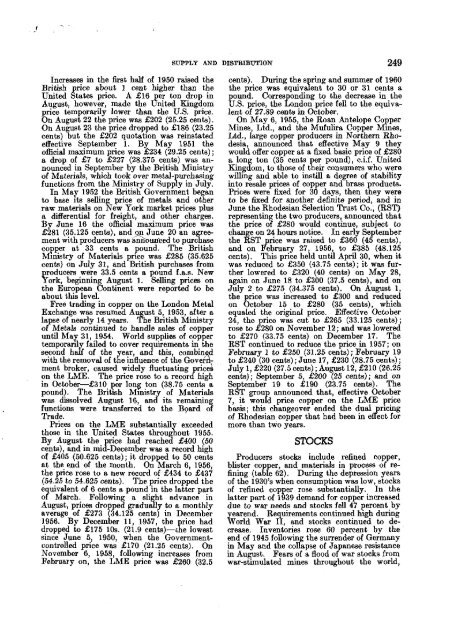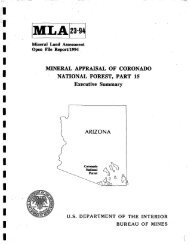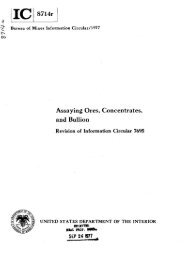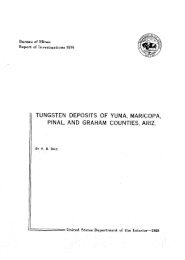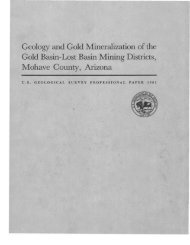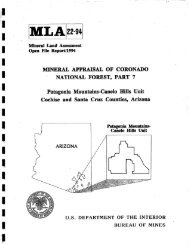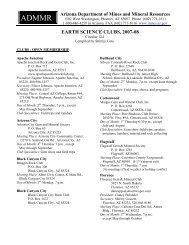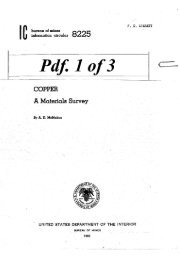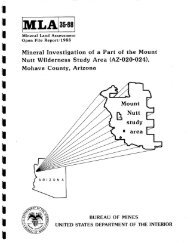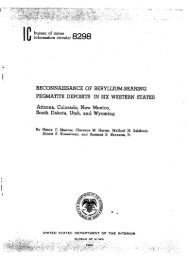IC 8225 - State of Arizona Department of Mines and Mineral ...
IC 8225 - State of Arizona Department of Mines and Mineral ...
IC 8225 - State of Arizona Department of Mines and Mineral ...
Create successful ePaper yourself
Turn your PDF publications into a flip-book with our unique Google optimized e-Paper software.
Increases in the first half <strong>of</strong> 1950 raised theBritish rice about 1 cent higher than theUnited 8 tates price. A £16 er ton drop inAugust, however, made the 8nited Kingdomprice temporarily lower than the US. price.On August 22 the price was £202 (25.25 cents).On August 23 the price dropped to £186 (23.25cents) but the £202 quotation was reinstatedeffective September 1. By May 1951 theo5cial maximum price was £234 (29.25 cents) ;a drop <strong>of</strong> £7 to £227 (28.375 cents) was announcedin September by the British Ministry<strong>of</strong> Materials, which took over metal- urchasingfunctions from the Ministry <strong>of</strong> SupJy in July.In May 1952 the British Government beganto base its selling price <strong>of</strong> metals <strong>and</strong> otherraw materials on New York market prices plusa differential for freight, <strong>and</strong> other charges.By June 16 the <strong>of</strong>ficial maximum price was£281 (35.125 cents), <strong>and</strong> on June 20 an agreementwith producers was aaunced to purchasecopper at 33 cents a pound. The BritishMinistry <strong>of</strong> Materials pnce was £285 (35.625cents) on July 31, <strong>and</strong> British purchases fromroducers were 33.5 cents a pound f.a.s. New!fork, beginning August 1. Selling prices onthe European Continent were reported to beabout this level.Free trading in copper on the London MetalExchange was resumed Anpt 5,1953, after alapse <strong>of</strong> nearly 14 years. he British Min~stry<strong>of</strong> Metals continued to h<strong>and</strong>le sales <strong>of</strong> copperuntil May 31, 1954. World supplies <strong>of</strong> coppertemporanl failed to cover requirements in thesecond h d <strong>of</strong> the ear, <strong>and</strong> this, combin, dwith the removal <strong>of</strong> tze influence <strong>of</strong> the (lover$ment broker, caused widely fluctuating priceson the LME. The price rose to a record highin October--£310 per long ton (38.75 cents apound). The BritLsh Ministry <strong>of</strong> Materialswas dissolved August 16, <strong>and</strong> its remaininfunctions were transferred to the Bprd o ";Trade.Prices on the LME substantiall exceededthose in the United <strong>State</strong>s throug 1 out 1955.By August the rice had reached £400 (50cents), <strong>and</strong> in mix~ecember was a record high<strong>of</strong> £405 (50.625 cents); it dropped to 50 centsat the end <strong>of</strong> the month. On March 6, 1956,the price rose to a new record <strong>of</strong> £434 to £437(54.25 to 54.625 cents). The price dropped thee uivalent <strong>of</strong> 6 cents a pound in the latter part09 March. Following a sli ht advance inAugust, prices dropped gradu & y to a monthlyaverage <strong>of</strong> £273 (34.125 cents) in December1956. By December 11, 1957, the price haddropped to £175 10s. (21.9 cents)-~he lowestsince June 5, 1950, when the Governmentcontrolledprice was £170 (21.25 cents). OnNovember 6, 1958, following increases fromFebruary on, the LME price was £260 (32.5SUPPLY AND DISTRIBUTION 249cents). During the s ring <strong>and</strong> summer <strong>of</strong> 1960the price was equiv 3 ent to 30 or 31 cents apound. Corresponding to the decrease in theUS. price, the London price fell to the equivalent<strong>of</strong> 27.89 cents in October.On May 6, 1955, the Roan Antelope Copper<strong>Mines</strong>, Ltd., <strong>and</strong> the Mufulira Copper <strong>Mines</strong>,Ltd., large copper producers in Northern Rhodesia,announced that effective May 9 theywould <strong>of</strong>fer copper at a fixed basic price <strong>of</strong> £280a lon ton (35 cents per pound), c.i.f. UnitedKing f om, to those <strong>of</strong> their consumers who werewilling <strong>and</strong> able to instill a degree <strong>of</strong> stabilityinto resale prices <strong>of</strong> copper <strong>and</strong> brass products.Prices were fixed for 30 days, then they wereto be fixed for another definite period, <strong>and</strong> inJune the Rhodesian Selection Trust Co., (RST)representing the two producers, announced thatthe price <strong>of</strong> £280 would continue, subject tochan e on 24 hours notice. In early Septemberthe $ST price was raised to £360 (45 cents)<strong>and</strong> on February 27, 1956, to £385 (48.12;cents). This price held until April 30, when itwas reduced to £350 (43.75 cents); it was furtherlowered to £320 (40 cents) on May 28,again on June 18 to £300 (37.5 cents), <strong>and</strong> onJuly 2 to £275 (34.375 cents). On August 1,the price was increased to £300 <strong>and</strong> reducedon October 15 to £280 (35 cents), whichequaled the original price. Effective October24, the price was cut to £265 (33.125 cents);rose to £280 on November 12; <strong>and</strong> was loweredto £270 (33.75 cents) on December 17. TheRST continued to reduce the price in 1957; onFebruary 1 to £250 (31.25 cents); February 19to £240 (30 cents); June 17, £ 230 (28.75 cents);July 1, £220 (27.5 cents) ; August 12, £210 (26.25cents); September 5, £200 (25 cents); <strong>and</strong> onSe tember 19 to £190 (23.75 cents). TheR ~ grou T announced that, eilective October7, it wo& price copper on the LME pricebasis; this changeover ended the dual<strong>of</strong> Rhodesian copper that had been in e fPricing ect formore than two years.STOCKSProducers stocks include refined copper,blister copper, <strong>and</strong> materials in process <strong>of</strong> refining(table 62). During the depression years<strong>of</strong> the 1930's when consumption was low, stocks<strong>of</strong> refined copper rose substantially., In thelatter part <strong>of</strong> 1939 dem<strong>and</strong> for copper increaseddue to war needs <strong>and</strong> stocks fell 47 percent,byearend. Requirements continued high d mgborld War 11, <strong>and</strong> stocks continued to decrease.Inventories rose 60 percent by theend <strong>of</strong> 1945 following the surrender <strong>of</strong> Germanyin May <strong>and</strong> the collapse <strong>of</strong> Japanese resistancein August. Fears <strong>of</strong> a flood <strong>of</strong> war stocks fromwar-stimulated mines throughout the world,


